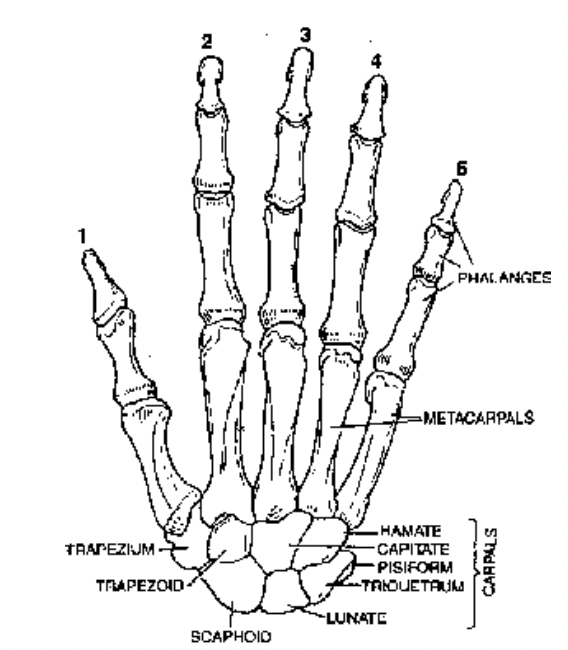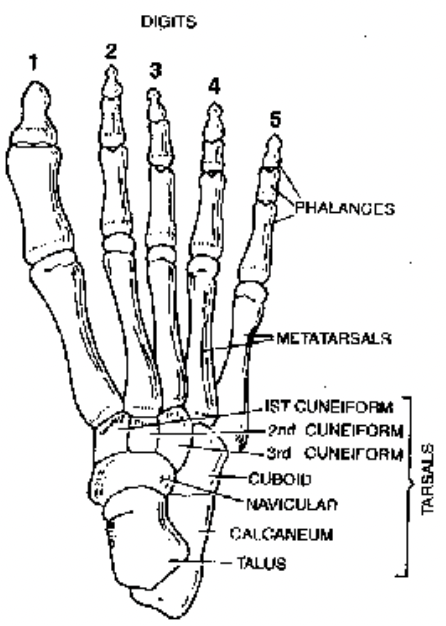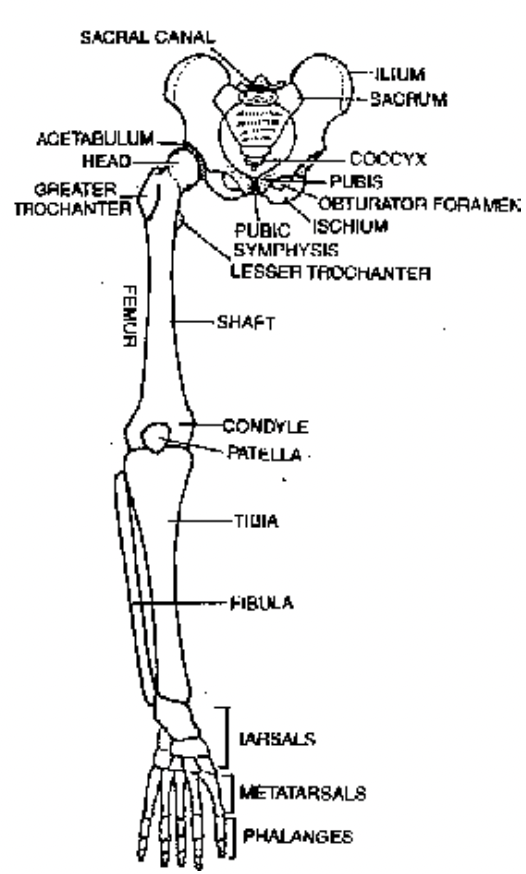Limb Bones
Movement and Locomotion of Class 11
They are of two types, fore limbs and hind limbs.
1. Bones of Fore-Limbs. There is a pair of fore-limbs or upper limbs. Each fore-limb has 30 bones and three parts—upper arm, lower or fore-arm and hand. Upper arm has only one bone, fore arm two bones while remaining 27 bones belong to hand. Humerus is the single long bone of upper arm. Its body is called shaft. Upper or proximal end bears a round head. Below it is present a narrow neck and two
tuberosities— greater tuberosity and lesser tuberosity. A deltoid tuberosity occurs over the shaft- Distal end of humerus has a pulley-like trochlea (attachment of ulna), convex capitulum (attachment to radius) and outgrowths or epicondyles.
The two bones of fore or lower arm are radius and ulna. Both are curved with radius towards thumb side and ulna towards the side of little finger. The two bones may lie parallel to each other or cross each other.
The latter happens when palm is kept in backward position. Radius is shorter than ulna. Its lower end is broader with two articular facets for carpals. Proximal end of ulna is elongated to form olecranon that produces elbow joint. Distal end of ulna has one facet for attachment of carpal.


Fig. Pectoral girdle & arm bones (anterior view) Fig. Bones of hand (dorsal aspect)
Hand has 8 bones in wrist region, 5 in palm region and 14 bones in fingers. The eight bones of wrist region are called carpals. Carpals are small and irregular. They occur in two irregular rows. Five bones of
palm are called metacarpals. The first metacarpal is short and stout. Metacarpals are expanded distally forming knuckles. Bones of the digits are called phalanges. They are 14 in number. Two phalanges occur in thumb, three each in other fingers. Phalanges have broader ends except for the distal ends of last phalanges which are narrow.
Carpal bones (wrist bones) are 8 in number i.e., Scaphoid, Lunate, Triquetrum, Pisiform, Trapezium, Trapezoid, Capitate, Hamate. Phalanges are finger bones. A single bone of the finger is called
Phalanx. First digit or first finger is called Pollex or thumb. (Thumb, Index finger, middle finger, ring finger, little finger)
Functions (i) Fore limbs have opposable thumb which helps in catching and holding of articles. (ii) They are used in lifting and throwing. (iii) The limbs are used in caring of body.
Bones of Hind Limbs (Lower Extremities). Bones of a hind limb are thirty in number—one in thigh, two in shank, one over knee and 26 in the foot region. The single bone of thigh is called femur. Femur is the longest bone. It has a body or shaft. The upper end is swollen into head which fits in acetabulum of pelvic girdle. Head is followed by a narrow neck and two ridges, greater trochanter and lesser trochanter.
Shaft is curved. Its concave side has a ridge. The distal end of femur has a central groove and two lateral condyles. A triangular disc-shaped patella or knee cap fits over intercondylar groove.
The two bones of shank are tibia and fibula. Tibia is inner and thicker with a sharp crest. Its proximal end has concave facets for fitting over condyles of femur. Distally, it bears a projection on inner side called medial malleolus. Fibula is outer and slender bone of shank which is projected distally to form external malleolus.
Foot has seven bones in ankle region, 5 bones in sole region and 14 bones in toes. Seven bones of ankle region are called tarsals. They have different sizes and shapes. Tarsals are arranged in three rows. 2 + 1+4.
The two tarsals of proximal row are large with calcaneum forming the heel and talus forming the ankle joint. Five bones of sole are called metatarsals. First metatarsal is short and strong. Phalanges have 14 bones, two in great toe and 3 each in other toes.
Tarsal bones (Ankle bones) are 7 in number i.e., talus (upper most, it is the only bone of foot which articulates with tibia and tibula, during walking it initially bears entire weight of body), calcaneus (heel bone,
it is largest and strongest bone tarsal bone), cuboid (it articulates with metatarsals no. IV and V), Navicular, cuneiforms (3, articulate with metatarsals). Phalanges are bones of toes. First toe is called hallux or great toe or big toe.


Fig. Bones of the foot (dorsal aspect) Fig. Human Pelvic girdle, sacrum, coccyx & bones of leg
- Introduction
- Skeletal System
- Types of Skeletal System
- Skeletal System in Man
- Appendicular Skeleton
- Limb Bones
- Type of Bones
- Joints
- Levers
- Disorder of Skeletal System
- Muscles
- Structure of Skeletal Muscle
- Physiological Aspects of Muscle
- Biochemical Aspects
- Types of Muscle Fibres
- Exercise 1
- Exercise 2
- Exercise 3
- Exercise 4
- Exercise 5









